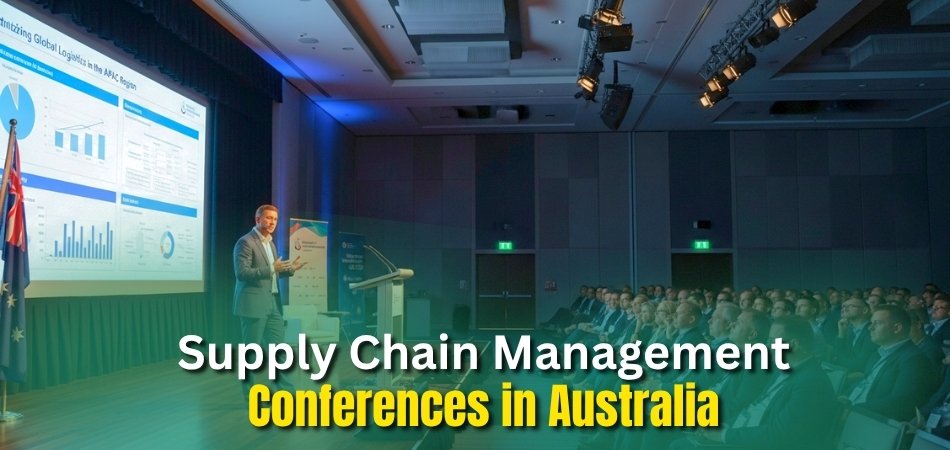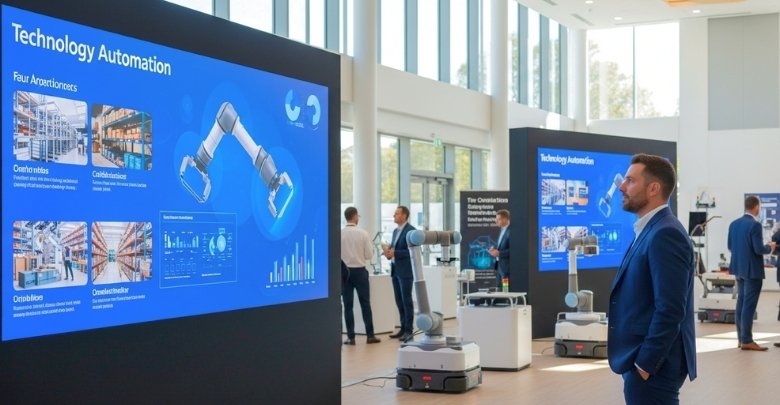Supply chain management conferences bring together experts, businesses, and technology leaders from across industries. These events highlight the latest trends, strategies, and tools shaping the future of logistics and planning. Many professionals often look for the top 10 supply chain management conferences in Australia to stay informed and connected with industry updates.
Attending supply chain events builds skills, planning, and logistics. Key events include the 74th Global Conference on Supply Chain Management, International Conference on Supply Chain Management and Logistics, and 69th Global Conference on Strategic Management and Planning. These conferences cover strategy, technology, and operations.
Are you curious to see how these conferences add value with workshops, live demos, and networking opportunities? If so, keep reading because this article explains every important detail about these events and what you can expect from each one.
Top 10 Supply Chain Management Conferences in Australia
| Date | Conference Name | Location |
| November 15, 2025 | 74th Global Conference on Supply Chain Management | Sydney, Australia |
| February 2–3, 2026 | International Conference on Supply Chain Management and Logistics | Melbourne, Australia |
| November 15, 2025 | 69th Global Conference on Strategic Management and Planning | Sydney, Australia |
| March 18–19, 2026 | Retail Fulfilment Show 2026 | Melbourne Convention & Exhibition Centre |
| April 29, 2026 | Retail Supply Chain & Fulfilment Summit VIC 2026 | Melbourne, Australia |
| May 19–20, 2026 | ProcureCon Australia Summit 2026 | Australia (venue TBA) |
| June 23–25, 2026 | CeMAT Australia (Intralogistics, Robotics & Supply Chain Show) | Melbourne, Australia |
| June 4, 2026 | Supply Chain Summit NSW 2026 | Sydney, New South Wales, Australia |
| July 7–9, 2026 | International Conference on Bulk Materials Storage, Handling & Transportation | Perth, Australia |
| September 16–17, 2026 | MEGATRANS Expo / Conference | Melbourne, Australia |
1. 74th Global Conference on Supply Chain Management (GCSCM)
This gathering is designed to bring international experts together to share updates and strategies. It will be held on November 15, 2025, in Australia. Known as one of the most followed conferences in Australia, the event usually includes discussions about supply chain challenges, smarter planning methods, and future-ready systems. Attendees can expect a wide variety of sessions that focus on building strong practices in global supply chains.
2. International Conference on Supply Chain Management and Logistics
A broad range of supply chain and logistics themes will be covered here. Taking place on February 2–3, 2026, in Melbourne, this event will highlight sustainable operations, smart logistics, risk management, and integration methods. Hosted by Conference Index, the program will allow professionals to learn about the role of IT and technology in improving supply chain efficiency.
3. 69th Global Conference on Strategic Management and Planning (GCSMP)
Industry leaders and planners come together at this event to discuss future directions. It is scheduled for November 15, 2025, in Australia. The conference is designed to provide insights into management strategies, decision-making, and advanced planning tools. This helps organizations align their goals with stronger and more efficient supply chain frameworks.
4. Retail Fulfilment Show 2026
This show focuses strongly on the retail side of supply chain operations. The event is scheduled for March 18–19, 2026, at the Melbourne Convention & Exhibition Centre. Topics such as e-commerce, last-mile delivery, inventory control, and warehouse intelligence will take center stage. The program is a great place to explore modern fulfillment solutions for the retail industry.
5. Retail Supply Chain & Fulfilment Summit VIC 2026
This summit puts retail supply chain concerns at the front of the conversation. The event is set for April 29, 2026, in Melbourne. It explores different aspects of fulfilment strategies, retail logistics, and ways to improve efficiency. The focus is largely on solutions that help retail businesses handle changing customer demands and fast-moving supply chain systems.
6. ProcureCon Australia Summit 2026
Experts in procurement and supply chain sourcing gather here to share knowledge. The summit is scheduled for May 19–20, 2026, in Australia, with the exact venue details still pending. Key topics include strategic procurement, leadership in sourcing, and building smarter buying systems. It serves as a hub for professionals seeking to improve sourcing and supplier relationships.
7. CeMAT Australia (Intralogistics, Robotics & Supply Chain Show)
This large exhibition is known for showcasing robotics, automation, and warehousing solutions. The event will be held on June 23–25, 2026, in Melbourne. The program dives into the future of intralogistics and material handling technologies. It is an excellent platform for exploring how automation and robotics can make supply chains more efficient and reliable.
8. Supply Chain Summit NSW 2026
The NSW summit is centered around the challenges faced within Australia. On June 4, 2026, this event will take place in Sydney, New South Wales. Discussions will focus on resilience, digital supply chains, and the unique supply concerns within the region. Attendees will gain insights into handling disruptions and building strong supply chain systems in Australia.
9. International Conference on Bulk Materials Storage, Handling & Transportation
This conference places focus on heavy industry and bulk material handling. It will be hosted in Perth, Australia, from July 7–9, 2026. The program highlights bulk storage systems, transportation technologies, and logistics infrastructure. Professionals working with heavy materials will find the sessions useful for learning about safe handling and efficient transportation in complex supply chains.
10. MEGATRANS Expo / Conference
A wide look at integrated logistics and sustainability is what makes this event important. Scheduled for September 16–17, 2026, in Melbourne, this expo will cover logistics, transportation, and modern supply chain technologies. Special attention is given to sustainable practices and advanced tools that improve overall logistics. The conference also provides a strong networking platform for industry professionals.
The growing importance of supply chain management makes these events valuable for anyone in the field. Attending them can help you understand current challenges, learn about advanced technologies, and connect with professionals who are shaping the future of logistics and operations.
Are Workshops and Hands-on Training Offered at Australian Supply Chain Conferences?
Many people want to know if supply chain conferences in Australia are only about speeches and talks. The good news is they are not just about listening. Many events now include workshops, case studies, and training sessions. If you are planning to join, you can expect practical activities too. Here’s what these workshops and practical sessions usually offer.
Workshops in Small Groups
Workshops are often set in a classroom-style format. Small groups work together on real challenges from the industry. This makes it easier to learn tools, compare ideas, and solve problems in a team. These sessions are often a main highlight for many attendees.
Hands-on With New Tools
Instead of only hearing about supply chain software, you can actually try it. Some conferences give attendees a chance to test digital systems, planning apps, and logistics platforms. This helps people learn faster because they see how the tools work in practice. It also makes the sessions more engaging and useful.
Live Demos on Show Floors
Exhibitions often bring a more practical touch. The show floor usually includes live demos of robotics and warehouse tech. Visitors can try trial runs and see automation in action. This makes it easier to picture how such systems might work in their own workplace.
Problem-solving Activities
Hands-on activities often include mini case studies. Teams are asked to work through supply chain issues and build solutions. This kind of interactive learning helps connect theory with real examples. It also builds confidence in using new strategies once people return to their jobs.
Value of Practical Sessions
These interactive formats are more than just fun add-ons. They give attendees skills they can take home and apply right away. From trying new systems to solving real cases, the learning feels more real. This mix of talks and training makes the event richer and more rewarding.
Workshops and live demos are now a strong part of supply chain events. Attendees not only listen but also get to try and test tools. This makes the learning more active, practical, and easy to use later. If you plan to join, be ready for a mix of talks and training.
How Do Supply Chain Conferences in Australia Address Global Trade Challenges?
Global trade is a big topic at supply chain events in Australia. These conferences focus on how businesses deal with fast-changing world markets. Speakers look at challenges like shipping delays, new trade rules, and rising costs. Keep reading to see how these events help firms handle global trade issues.
Focus on Global Pressures
Conferences often highlight how world markets affect local supply chains. Talks include import and export costs, trade bottlenecks, and freight disruptions. Many sessions look at how businesses can stay strong during global changes. Case studies show how firms adapt to rising costs and shifting rules. These discussions make global pressures easier to understand.
Dealing With Trade Rules
A major topic is how companies face changing trade regulations. Import and export rules often shift due to global crises or politics. Australian supply chain events explain how these changes impact local businesses. Sessions share tips on handling tariffs and compliance steps. This helps companies stay on track in tough trade conditions.
Building Supply Resilience
Events place a strong focus on keeping supply chains steady. Speakers show how technology like automation and robotics, helps reduce risks. Companies share ways to adjust plans when global supplies are delayed. Real stories explain how to keep goods moving during crises. These insights help firms prepare for unexpected disruptions in global trade.
Climate and Regulation Impact
Many conferences also talk about climate policies and green rules. Carbon border adjustments and emission targets can affect trade costs. Speakers discuss how new laws in other countries impact Australian companies. These talks show how supply chains must adapt to global climate policies. Businesses learn how to plan for a low-carbon future.
Learning From Real Companies
Supply chain events invite companies with real global trade experience. Many deal with cross-border logistics, Asia sourcing, or shipping delays. Case studies explain how they manage freight price swings and complex routes. Hearing these lessons gives others clear steps to apply in their work. It makes global trade challenges more real and useful.
Australian supply chain conferences connect local businesses with worldwide challenges. They explore trade rules, supply risks, and global climate policies. These events help firms find solutions that work across markets. If you want to see how global trade issues are tackled, these events are worth following.
Do Australian Supply Chain Conferences Feature Technology and Automation Trends?
Technology plays a big role in today’s supply chain events. These conferences in Australia focus on tools that improve speed and reduce costs. Visitors get to see how digital systems and machines are used in real work. If you want to know more, read the details below.
Robotics and Warehouse Automation
Many supply chain events in Australia showcase robotics and automation. You will see robots, drones, and warehouse machines that move goods quickly. These tools are made to cut down manual work and errors. Some events even highlight intralogistics and material handling systems. CeMAT Australia 2025 is one example where such displays are common.
Smart Warehousing and Data Use
Conference sessions often focus on smart warehousing and data use. Themes like end-to-end traceability, decision making, and automation are key. Experts talk about how smart systems improve speed and accuracy. 4th Annual Supply Chain Week highlights these points in detail. Data is shown as a tool that makes better business choices.
Live Demos and Exhibits
Trade shows in Australia offer live demos of supply chain technology. Visitors can see autonomous forklifts, sorting systems, and sensor setups. These real-time shows give clear ideas of how machines work. The exhibits make it easier to picture how automation fits into daily tasks. They also help compare different solutions in one place.
Digital Twin and Predictive Models
Speakers often explain digital twin and predictive model use. These tools help businesses simulate, test, and plan supply chain moves. By using IoT and analytics, risks can be reduced early. The focus is on smarter planning instead of guesswork. Such talks are common in Australian supply chain conferences.
Role of Technology in Conference Themes
Technology is not just a side topic in these events. It is deeply part of the themes, workshops, and speaker sessions. From warehouse machines to digital tools, the focus is clear. The events also bring global ideas into the local industry’s needs. This mix makes the conferences more practical and hands-on.
Supply chain conferences in Australia highlight real tools and working systems. Visitors can learn how robotics and smart data improve business tasks. These events focus on solving real challenges with new solutions. If you want to stay updated, these conferences are worth attending.
How Do You Network Effectively at Supply Chain Conferences in Australia?
Networking at supply chain conferences can feel a little overwhelming at first. These events often bring together many experts and industry professionals in one place. Meeting the right people can open doors to new ideas and business opportunities. With the right steps, you can turn short talks into lasting connections, so let’s look at how to do it well.
Attend Breakout and Workshop Sessions
Breakout and workshop sessions usually have smaller groups of people. This makes it easier to walk up to someone and start a chat. You can ask presenters about their points or share your own ideas. Being active in these sessions often leaves a strong impression. It is a smart way to meet like-minded professionals.
Visit the Exhibit Hall
Walking around the exhibit hall gives you a chance to meet vendors. Stop at different booths, ask about their products, and exchange details. This not only helps you learn about new solutions but also builds useful links. Vendors often remember people who show real interest. Take notes after each visit so you can follow up later.
Join Side Events and Social Functions
Evening mixers, dinners, or meetups allow for relaxed conversations. These events are less formal and make it easier to talk freely. You can get to know people outside of their work roles. Many lasting business ties start with casual chats over food or drinks. Make time for these events even if your schedule feels full.
Use the Conference App or Platform
Most conferences have apps that help connect attendees. You can see who is attending, send short messages, or plan meetups. These tools are great for setting up a chat before meeting in person. Sharing takeaways or posting about sessions also helps others notice you. It is a simple way to stay connected during the event.
Prepare Your Elevator Pitch
A short pitch makes it easier for people to remember you. Keep it clear, simple, and about thirty seconds long. Include your name, what you do, and what you want. This helps others understand how they can connect with you. Practice it before the event so you can say it with ease and confidence.
Networking works best when you go in with clear goals and plans. Meeting new people is easier when you know how to start. A little preparation helps you stand out and be remembered. Use these steps to turn conference talks into lasting business relationships.
What Should You Bring to a Supply Chain Management Conference in Australia?
Attending a supply chain management conference in Australia is a great chance to learn and meet people in the field. To make the most of it, pack smartly. Here’s a checklist of essentials you should bring.
- Business Cards or QR Code: Carrying a traditional business card or a digital QR code makes it easy to share your details quickly with new contacts during networking sessions.
- Notebook or Tablet: Having a notebook with pens or a tablet helps you write down ideas, take notes, and keep track of important discussions at the event.
- Charged Devices With Chargers: A phone, laptop, or tablet will be needed. Bringing chargers or a power bank ensures your devices do not run out during important moments.
- Company Profile Copies: Handing out a one-page company profile or a short presentation slide deck allows others to quickly understand what your business does and offers.
- Prepared Questions: Before the conference, think about challenges you face or ideas you want feedback on. Asking focused questions can spark more useful conversations.
- Comfortable Shoes: Events often require walking between sessions, booths, and meeting spaces. Wearing comfortable shoes ensures you stay relaxed and do not get tired quickly.
- Backpack or Lightweight Bag: Keeping a small, light bag helps you carry handouts, brochures, and freebies collected during the event without struggling with extra weight.
- Agenda or Schedule: Having a printed or downloaded version of the conference schedule saves time. It helps you plan and avoid missing sessions you really want.
- USB Stick With Files: Carrying a USB stick with your presentation, portfolio, or documents is useful if someone requests your materials in a direct and quick format.
- Badge Holder or Lanyard: Conferences require identification, and keeping your badge in a holder or lanyard makes it easy to access and prevents losing it during the day.
- Snacks and Water Bottle: Long events may not always have food options nearby. Having a small snack and a refillable water bottle keeps your energy up.
- Business Casual Clothes: Choosing neat but comfortable clothes helps you look professional while staying relaxed during long hours of sessions, networking, and walking around the venue.
By packing these items, you will be ready for both the learning and networking parts of the conference. This way, you can stay focused on gaining knowledge, building connections, and making the event experience more productive and enjoyable.
How Should You Follow Up After Attending a Supply Chain Conference in Australia?
Attending a supply chain conference is only the first important step. The real value comes from how you handle things afterward. Simple actions can turn short talks into lasting professional connections. Read below to see how you can follow up.
Send Thank You Messages
After the conference, reach out to the people you met. A short thank-you note by email or LinkedIn works well. Mention something you discussed to make your message personal and clear. This small action shows respect and builds trust. People appreciate it when you remember them and follow up quickly.
Connect on LinkedIn
Building your online network is easy with LinkedIn. When sending a connection request, add a short line about where you met. This helps the other person remember the conversation right away. A small detail makes your request feel real and personal. It is also a great way to stay updated.
Share Promised Resources
If you told someone you would share slides or articles, send them quickly. Delivering what you promised shows you are reliable and professional. People often forget, so sending it soon helps you stand out. Sharing useful resources also gives them a reason to reply. This can lead to further meaningful conversations.
Plan Follow-up Meetings
For contacts who seemed most valuable, suggest a call or coffee. Keeping it casual makes it easier for them to say yes. Be clear about what you want to discuss during the chat. Having a short agenda shows you respect their time. These small meetings can lead to bigger opportunities later.
Review Notes and Pick Actions
Take time to read through the notes you wrote. Decide which ideas or tools you want to try first. Having clear action points helps you make progress faster. Do not try everything at once; just start small. This simple step ensures the learning actually improves your work.
Following up after a conference makes the event worth your time. It helps you build new relationships and keep them strong. Simple actions often lead to better chances and results later. Use the tips above to turn learning into real benefits.
FAQs About Top 10 Supply Chain Management Conferences in Australia
Attending supply chain management conferences in Australia can raise many questions. People want to know how to prepare, what to expect, and what makes these events helpful. To make it simple, here are some clear and direct answers. This section covers the most common and useful points you should know.
What is the Main Purpose of Supply Chain Management Conferences in Australia?
The main purpose of these conferences is to bring people together to learn and share. They give experts, managers, and professionals a place to discuss supply chain challenges. Attendees gain new knowledge from sessions, case studies, and guest speakers. The goal is to improve supply chain systems with better planning, tools, and teamwork.
How Do Supply Chain Conferences in Australia Benefit Businesses?
Businesses benefit by learning new ways to cut costs and improve processes. Conferences often show real examples of how companies solved big problems. This gives attendees ideas they can use in their own work. Many also meet partners, suppliers, or customers, which can lead to future growth.
Who Usually Attends Supply Chain Conferences in Australia?
These events attract a wide range of people from different industries. You will see supply chain managers, logistics experts, procurement leaders, and technology providers. Researchers and academics also attend to share studies and insights. This mix of people makes the discussions richer and more useful for everyone.
How Much Time Do Supply Chain Conferences in Australia Usually Last?
The length of the event depends on the type of conference. Some are one-day or two-day events with talks and panels. Others can last three to four days with workshops and exhibitions. Longer events often give more chances for networking and learning in detail.
How Do Supply Chain Conferences in Australia Help With Professional Growth?
They help people grow by giving access to the latest knowledge. Attendees learn about global trends, smart tools, and strong practices. They can also improve their skills by joining workshops and discussions. Meeting industry experts and peers makes it easier to grow professionally.
What Topics Are Commonly Covered at Supply Chain Management Conferences in Australia?
Conferences usually cover planning, logistics, procurement, and technology in supply chains. Sustainability, risk management, and digital systems are also common themes. Many sessions look at global supply chain issues and local business challenges. This wide range of topics makes the conferences valuable for different industries.
How Do Supply Chain Conferences in Australia Support Innovation?
They support innovation by showcasing new tools and methods. Many events include exhibitions where companies present their latest technology. Attendees get to see real-life examples of robotics, automation, and smart systems. This helps them understand how innovation can improve their own supply chain work.
What Is the Role of Guest Speakers at Supply Chain Conferences in Australia?
Guest speakers share their knowledge and experience with attendees. They often include global leaders, researchers, or successful business professionals. Their talks highlight real challenges and practical solutions. Listening to them helps attendees learn lessons that can be applied directly at work.
How Do Supply Chain Conferences in Australia Encourage Collaboration?
Collaboration is encouraged through group sessions, panel talks, and networking breaks. Attendees are often invited to join discussions and share ideas. This creates a space where people can find common problems and work together on solutions. Partnerships and future business projects often start during these exchanges.
Why Are Supply Chain Conferences in Australia Important for the Future?
They are important because supply chains are always changing with new demands. Conferences help prepare businesses to deal with global trade, technology, and climate challenges. They also show future trends that can guide better planning. Attending them helps both individuals and businesses stay strong in a fast-changing world.
Conclusion
Attending supply chain conferences in Australia gives you a clear path to learning, growth, and new contacts. These events go beyond speeches by offering live demos, workshops, and case studies. With each session, attendees gain real tools and practical strategies to improve their work.
If you are searching for the top 10 supply chain management conferences in Australia, you now have a complete list of major events. They cover retail, logistics, procurement, automation, and bulk material handling, making them valuable for different industries that want to keep up with global and local changes.
Before attending, make a small checklist: bring business cards, prepare simple questions, and keep a positive mindset. After the event, follow up with new contacts and try one or two fresh ideas. Best wishes for making your next conference truly rewarding.









